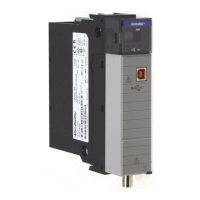Publication 1756-RM084F-EN-P - July 2002
3-2 Creating a Complete Import/Export File
Specifying DATATYPE attributes
You can specify these attributes for a DATATYPE:
Specifying a DATATYPE member
There are two kinds of data type members. A bit member is a member
in which only a single bit of information is to be accessed. A non-bit
member is a member that is defined as another data type (such as
SINT, INT, DINT, COUNTER, etc.).
A non-bit member definition follows this structure:
<
TypeName
> <
MemberName
> [
Attributes
];
All data types are allocated in 8-bit boundaries. A single bit of storage
is not allowed, so a member cannot be a BOOL data type. To access a
single bit, use the BIT declaration. BIT allows access to a single bit
within a host member (a non-bit member).
A bit member uses the following syntax:
BIT <
BitName
> <
HostMemberName
> : <
BitPosition
> [
Attributes
];
Attribute: Description:
Description
Provide information about the data type.
Specify:
Description := ”
text
”
FamilyType
Specify StringFamily for a string datatype. Specify
NoFamily for all other datatypes.
Specify:
FamilyType :=
text

